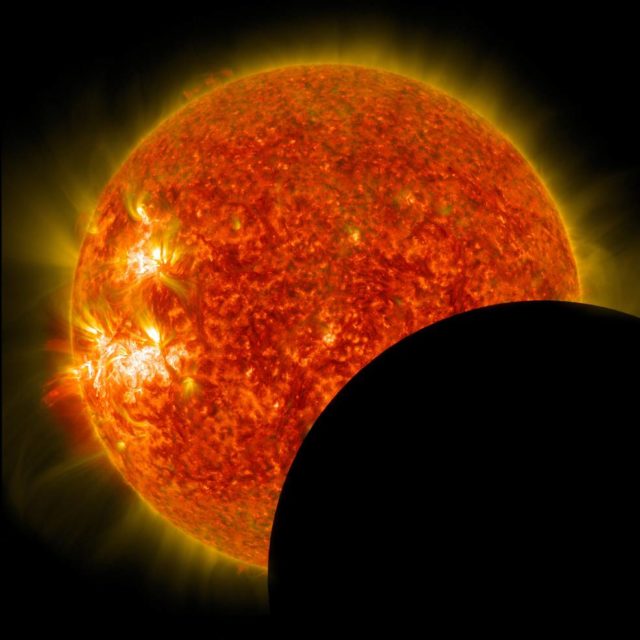
On August 21, 2017, a full solar eclipse will occur and be visible from much of the United States. This will be the first time since 1979, a full solar eclipse will be visible in the U.S.
Following is a collection of stories, from a variety of websites, on where the best viewing place is, how to view the eclipse and a lot more, including how YOU can help NASA.
These posts are in no particular order, many contain videos. Much of the information may be duplicated.
NASA.gov: NASA Recommends Safety Tips to View the August Solar Eclipse
More than 300 million people in the United States potentially could directly view the Aug. 21 total solar eclipse, and NASA wants everyone who will witness this celestial phenomenon to do so safely.
That Monday, a partial eclipse will be visible in every state. A total solar eclipse, which is when the Moon completely covers the Sun, will occur across 14 states in the continental U.S. along a 70-mile-wide (112-kilometer-wide) swath of the country.
It’s common sense not to stare directly at the Sun with your naked eyes or risk damaging your vision, and that advice holds true for a partially eclipsed Sun. But, only with special-purpose solar filters, such as eclipse glasses or a handheld solar viewer, you can safely look directly at the Sun.
Buzz60: A total solar eclipse is coming on August 21, and even if you’re not astronomically blessed enough to be in its path, you won’t be left in the dark. Buzz60’s Amanda Kabbabe (@kabbaber) has more.
Space.com: Final New Moon Sunday Starts the Countdown to the Great American Eclipse
It seems that everyone is eagerly awaiting the shady drama that will be enacted in the skies over North America on Aug. 21. It is a play whose script was written eons ago: On that third Monday in August, the celestial wanderings of the sun, Earth and moon will cause our natural satellite to pass directly in front of the sun, resulting in a total eclipse on Aug. 21.
NASA.gov: Eclipse Across America: Path Prediction Video
Where will you be during the Eclipse across America? On August 21, the shadow of the Moon will cross the continental USA for the first time since 1979. The predicted path — a certainty given modern astronomical knowledge — is shown in the featured NASA video. Most people in the USA will be within a day’s drive to the path of the total solar eclipse, while the rest of North America will see a partial solar eclipse. In the path of totality, given clear-enough skies, the Moon will block out the Sun making it eerily dark for as long as 2 minutes and 40 seconds. If interested in attending an eclipse party, please contact your local amateur astronomical society, science center, park, or university to see if one is already being planning. Some eclipse chasers have traveled to the end of the world to see a total eclipse of the Sun, and along the way have recorded many entertaining adventure stories.
Video Credit: NASA GSFC‘s Scientific Visualization Studio; Blue Marble data courtesy Reto Stöckli (NASA/GSFC)
DigitalTrends.com: Nasa Needs Your Help For The Upcoming Full Solar Eclipse In The U.S.
Getting a job at NASA is no walk in the park, but contributing to its upcoming science experiment could be just that easy. While we can’t all be astronauts or rocket scientists, we can download NASA’s new GLOBE Observer Eclipse app and record data during the upcoming full solar eclipse. The natural phenomenon, slated to take place on August 21, 2017, is expected to be one of the largest in recent memory, and will actually be the first time Americans will be able to see such an eclipse since 1979. Heralded as the “Great American Total Eclipse,” it’ll be visible to the residents of 14 states — 12 will be in the direct path of the eclipse, while two will catch the edge.
USAToday.com: 200 million people are within just one day’s drive of the solar eclipse. What you need to know
On Aug. 21 we will see the first solar eclipse in the U.S. since 1979. Our graphic explains exactly what one is, shows it’s path and some how-to viewing tips. By Ramon Padilla, Karl Gelles, Dann Miller, Walbert Castillo, Janet Loehrke and Sara Wise, USA TODAY NETWORK
Got eclipse fever yet?
The biggest and best solar eclipse in American history is less than two months away.
On Aug. 21, 2017, a total solar eclipse will be visible from coast to coast, according to NASA. It will be the first total eclipse visible only in the USA since the country was founded in 1776.
Space.com: Solar Eclipse Day Craziness Could Resemble the Zombie Apocalypse — Are You Ready?
LiveScience.com: 10 Solar Eclipses That Changed Science
Although they were once feared as an evil omen, solar eclipses have helped to shape human history — and a few solar eclipses, in particular, have helped to guide philosophers and scientists to a better understanding of the heavens and our true place in the universe.
Here is a countdown of 10 solar eclipses that changed science.
Space.com: 6 of the Best Places to See the Total Solar Eclipse of 2017
Some people may think it absurd to travel hundreds or thousands of miles to see an event that will last less than 3 minutes, but millions of people are expected to do just that to witness the total solar eclipse on Aug. 21. In addition to watching this breathtaking celestial show, there are many other things to see and do in and around the eclipse path.
Mashable.com: New solar eclipse simulator shows you what to expect this summer
A big solar event is taking place across North America in August and to prepare for the big blackout (a whole two minutes in some places) Google and UC Berkeley teamed up to show what the total solar eclipse will look like based on where you are.












